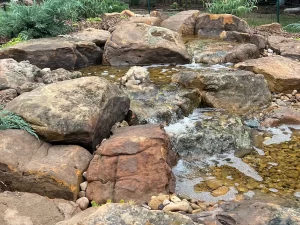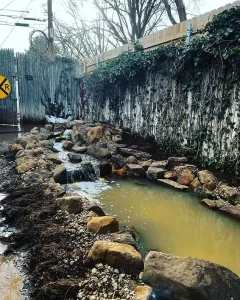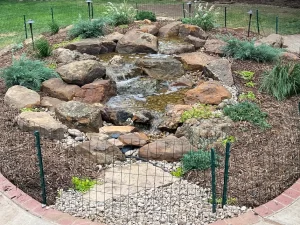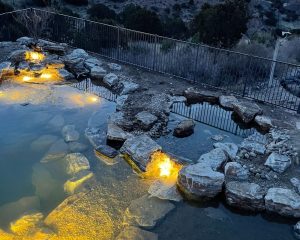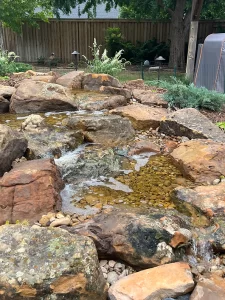Backyard Pond Design & Installation
We design and build beautiful, sustainable, natural looking ponds
What Makes A Backyard Pond Great?
Every element we incorporate into one of our backyard ponds serves a very specific purpose.
Aquatic Plants
Aquatic plants play an important role in your pond, as they provide a variety of benefits to both the fish and the ecosystem. Some of the key roles that aquatic plants play in a pond include improving oxygenation, supporting filtration, creating fish habitat, and enhancing the appearance of the pond.
Fish Caves
Fish caves can serve several important functions in a koi pond. They can provide a sense of security for the fish, which can help to reduce stress and promote healthy growth. They can also help to protect fish from predators and can provide a shaded area where fish can retreat from the sun and heat.
Filtration System
Koi ponds require proper filtration systems to ensure the water remains clean for the fish and plants. Filtration helps remove debris, waste, and excess nutrients, which can lead to poor water quality and the growth of harmful bacteria. There are a few different types of filtration systems including mechanical, biological, and chemical filtration.
Pond Lighting
Koi pond lighting can be an important aspect of designing and maintaining a koi pond. Lighting can not only enhance the visual appeal of the pond, but it can also serve practical purposes such as providing light for the fish and allowing for evening viewing.
Water Features
There are a variety of water features that we can integrate into your new koi pond. These can include cascading waterfalls, water fountains, bubblers, and more. These all add ambience, and improve the aesthetics of your koi pond while adding the peaceful sounds of moving water.
Surrounding Landscape
A koi pond on it's own is an exciting landscape feature. When you surround your pond with complimentary landscaping it takes your natural display to an entirely new level. The right combination of plants, and natural elements such as rock and driftwood really set the stage.
Frequently Asked Questions About Koi Ponds
Our Koi Pond Design Process
The koi pond design process involves several key steps that help us to ensure that the final product we build for you is both beautiful and sustainable. We're not just building a pond. We're building an entire ecosystem and that takes knowledge and careful thought. The following is a general overview of our koi pond design process:
#1. Planning: The first step in designing a koi pond is to plan the overall layout and size of the pond. We need to consider factors such as the size of the available space, the intended use of the pond, how many and how large of koi you'd like to have, and the style of the surrounding landscaping. We'll also want to think about the pond's shape, depth, and location on your property.
Should you wish to proceed after an initial consultation we'll move onto actually creating a design, implementation plan, and providing you with a formal estimate for your new koi pond.
#2. Site preparation: If you're happy with our design concept and our estimate and you choose to move forward, we'll need to prepare the actual site for the pond and planning for necessary utilities to support your pond such as water and electrical.
#3. Design: Once the site is prepared, we can begin to actually layout the pond, including the shape, size, location of the various features and the overall aesthetic. While it's not complete at this stage, we've at least established where everything is going to go and how it's all going to work.
#4. Construction: Once the design and layout is complete, we can begin the actual construction process, which typically involves digging the pond, installing a liner, and adding any necessary filtration and circulation systems. We can also rough-in some of the additional features such as fish caves, waterfalls, rock displays, and more.
#5. Finishing touches: Once the construction is complete, we can add the finishing touches, such as ensuring the water quality is perfect for the new koi, planting the aquatic plants, finalizing the installation of waterfalls or other features, and then the exciting part, stocking the pond with your new koi.
#6. Maintenance: The final step in the process is to establish a regular maintenance routine to ensure that the pond remains clean and healthy for the fish and plants. Remember, this is an ecosystem. It needs an appropriate balance to thrive. This includes cleaning the pond, maintaining proper water chemistry, and monitoring the health of the fish and plants.
At ALS we have many years of experience designing and building backyard ponds. Our goal is to ensure that your constructed pond is safe, healthy and sustainable for the fish and the new ecosystem.
We recommend koi ponds are no shallower than 24 inches. This depth is ideal because it allows hardy aquatic plants to thrive without freezing, but also allows enough room to raise koi and goldfish. If your space and budget allow, we like to dig ponds closer to 2.5 or 3 feet deep. This depth gives your fish plenty of room to retreat when threatened and gives the pond a more unique look.
Koi Pond Filtration Systems
Filtration systems are an essential component of a koi pond, as they help to keep the water clean and healthy for the fish. Koi ponds are typically stocked with a high density of fish, and without proper filtration, the water in the pond can become polluted with waste products and other contaminants. This can lead to a buildup of harmful bacteria and other microorganisms, which can make the fish sick and cause the pond to have an unpleasant odor.
There are several types of filtration systems that can be used in koi ponds, each with its own advantages and disadvantages.
The two most popular koi pond filtration systems are:
Mechanical filtration: This type of filtration uses a physical barrier, such as a filter pad or screen, to remove debris and other solid particles from the water.
Biological filtration: This type of filtration uses beneficial bacteria to break down harmful waste products, such as ammonia and nitrite, in the water.
Smaller koi ponds can often get away with choosing one or the other but for larger koi ponds the best solution is a combination of these two filtration systems.
Biological filtration in a koi pond works by using beneficial bacteria to break down harmful waste products, such as ammonia and nitrite, in the water. These waste products are produced by the fish waste and other organisms in the pond, and can slowly build up over time, leading to poor water quality and making the fish sick.
The process of biological filtration takes place in a bio-filter, which is a specialized filtration system that provides a surface for the bacteria to colonize. Water is pumped into the bio-filter and flows through a medium, such as a filter pad, ceramic rings, bio-balls or bio-brick, which provides a surface for the bacteria to grow on.
The beneficial bacteria that are used in a bio-filter are called Nitrifying bacteria, which are able to convert the harmful waste products in the water into less harmful substances. The first type of bacteria is called Nitrosomonas, which convert ammonia into Nitrite, and the second type of bacteria is called Nitrobacter which convert Nitrite into Nitrate. Nitrate is much less harmful to fish and can be removed through water changes or through the use of plants that are able to absorb it.
It's important to note that the process of biological filtration is a delicate balance and the right conditions must be met for the bacteria to thrive. These conditions include proper temperature, pH, oxygen levels and the presence of a food source (waste products) in order to establish and maintain a healthy population of Nitrifying bacteria.
Biological filtration is an essential component of a koi pond filtration system, as it helps to keep the water clean and healthy for the fish. It is often used in conjunction with other types of filtration, such as mechanical filtration, to provide comprehensive water treatment for a koi pond.
While the two may look similar from a passing glance, koi and goldfish are two very different species. One way to tell them apart is by the "whiskers," known as barbels. Koi fish have barbels on each side of their mouths. Goldfish, on the other hand, lack these barbels. So, if your fish has "whiskers," it's definitely a koi.
You can also tell the two apart by looking at the dorsal fin closest to the tail. If the dorsal fin is attached to the back, it's a koi. A non-attached dorsal fin means it's a goldfish.
Koi fish also grow to be much larger than their goldfish cousins in adulthood. But don't worry: even though they're different, koi and goldfish typically get along just fine.
If you still have trouble identifying your fish or want advice on which species is best for your pond, we would be happy to answer your questions!
If you are having a problem with predators targeting your pond, you are not alone. This is a question that pops up every season. There are many options you can try to keep large birds and other predators away from your pond. Unfortunately, though, a heron will eventually outsmart most efforts.
The most effective way to protect your finned pets is to install a protective net. While this is very effective, some people find the net too distracting as a permanent solution. You might also consider running fishing line around the perimeter of your pond. The heron will not like having to contend with the line and will eventually find somewhere else to hunt.
Another solution is giving your fish a hiding place. If your pond does not have a good place for your fish to hide, you may want to consider adding one. We suggest two different methods. The first is an easy to install fake stump made by Aquascape. Depending on the size of your pond and fish, this may be a good option. The second option is letting us install a "fish cave." To create this feature, we use heavy drain pipe and disguise it using matching rocks, boulders, and gravel, ultimately creating a built-in cave that blends beautifully into your pond.
Yes! A properly installed net cover keeps leaves and other winter debris from blowing into your pond and overwhelming your skimmer or pump. More importantly, winter debris can host dangerous parasites that take advantage of your fish while their immune systems are low due to the cold.
We recommend switching to a winter and fall formula fish food starting in September. Stop feeding your fish once the water temps dip below 55 degrees. During the early spring, you will notice your fish grazing around the pond, and maybe even coming up to you, wanting to be fed. However, during these warm streaks, there is actually plenty of organic algae and debris in the pond that the fish will eat. This material is much easier for them to digest during temperature fluctuations.
Once the water is consistently above 55 degrees, you can begin to feed small amounts of spring formula fish food. In May, you can switch to your favorite summer formula.
No! Especially during the warmer months, your fish are more active, meaning they are consuming more oxygen and putting off more waste. Turning off your system means there is less oxygen. Over time, fish waste quickly builds up to unsafe levels. Leaving your pond running year-round is always recommended if you have fish.
This is a common question we hear from new pond owners. During the winter months, your fish become very sluggish and tend to stay near the bottom of the pond, where they find warmer pockets of water. As long as your pond is below the ground and has a pump running, you should have no problems with your fish during the winter.
We also recommend raising any aeration from the bottom of your pond and bringing it closer to the surface. If possible, run your pond year-round. This makes sure that the pond does not freeze over completely and allows the gases to pass from your pond.
Unusually green water could mean several things. It might mean an abundance of nutrients in your pond, but not enough filtration or plants to consume those nutrients. When nitrates and phosphate levels are high, but there aren't enough plants to feed on them, algae will begin to take over. The greenish color you see is actually single-cell floating algae. Unfortunately, this is very common in ponds that are constructed AWAY from the ecosystem style.
Your best option is to treat the algae as a symptom of a larger problem. First, determine the cause. A lack of plant life is almost always the culprit. New plants in your pond will start competing with the algae for the same nutrients, and eventually, the algae will die out. Shade plants help too. They'll steal the sunlight away from algae, which causes it to die.
You might also choose to combat green water by installing a UV light, which quickly kills the algae. We do not install many of these devices, but they are very effective at killing green water. However, even with the UV light, you may need to do a few 20% water changes as the algae are dying off to prevent them from building up in the system.
Algae growth can be both alarming and unattractive. But algae isn't always a major concern. However, sometimes it can be dangerous to your fish and aquatic plants if not controlled properly. Therefore, you should always contact us if you notice algae growth.
First, it's important to determine what is causing the algae growth. Is it caused by excess debris, fish or plant waste, or improper cleaning? Is poor aeration of filtration causing algae growth? Your best option is to call a Pond Pro from Amarillo Land Services. We can diagnose the cause of your algae growth and recommend a plan to get your pond healthy again.
Common solutions include introducing additives to your pond, cleaning out your water feature, adding more aquatic plants, or repairing/adding new aeration or filtration systems.
That all depends. There are many factors that determine how many fish you can have. Aeration, the effectiveness of your filtration system, and gallons of water all contribute to a healthy ecosystem for your fish.
A good rule of thumb is one adult koi (over 12") for every 250 gallons of water. So, if you have a 10x14x2 pond (measuring inside the rocks and gravel) then your pond holds 2,100 gallons of water. Assuming your pond was properly constructed, you can have up to eight adult koi.
But here is where it gets interesting; this math is for adult koi, not babies. Adult koi require a far greater amount of dissolved oxygen than smaller fish.Plus, adult koi put off much more ammonia when breathing and pooping! It is not uncommon to stock a new koi pond with baby fish (I am guilty of this myself!). While this is fine for the first few years, your fish and your pond will become unhealthy over time, as the koi grow. Without the proper space, you will have to find new homes for your finned pets…or build another pond!
It is very important to know how many gallons your pond holds. This information allows both you and your pond service team to properly service your pond by:
- Adding the correct water treatments to the pond
- Preventing money waste from overdosing with beneficial bacteria
- Making sure your biological filtration system is adequate based on your water capacity and fish load.
The quickest way to determine how many gallons your pond has is to find your average length, depth, and width of your pond. Then, multiply them all by 7.5 (the space a cubic gallon of water takes up in your pond). For instance, if your pond is 8' wide, 11' long, and 2' deep on average then your formula will look like this:
8 x 11 x 2 x 7.5= 1,320 gallons
However, if your pond has rocks or gravel, including rock shelves, take your measurements on the inside of the rocks. This way, you're not factoring in water that the rocks and gravel displace.
If Amarillo Land Services built or regularly services your pond, you can contact us directly and ask about your pond's size. We keep track of all projects and will be able to give you accurate gallon measurements.
That depends on how your pond was constructed. If your pond is built using the "ecosystem" method (which we use here at Amarillo Land Services), then yes, it is easy to maintain! The ecosystem pond works with mother nature and not against her. Just like a natural body of water, your pond requires a proper balance of fish, plants, aeration, and bacteria to remain healthy.
The ponds we design and build have a mechanical filter (usually a skimmer or intake bay), areas designed for plants to feed directly from the pond, and waterfall features for aeration. Plus, we add a biological filter that hosts billions of nitrifying bacteria. These bacteria remove toxins put off by the fish and decaying organic matter. It's the circle of life, contained in your pond!
What Our Customers Say

The young man was very professional and knowledgeable. Made his visit pleasant.
A great company who does what they say they are going to do and with quality. They also returned months later to help us with something that was not their responsibility. We are so grateful for their help and them taking care of us.
Had a repair done last April that came undone. Tyler came out and repaired the leak at no charge. Felt nice to be taken care of!
The owner stayed on top of the process of installing a sprinkler system in my front and back yards. My back yard presented some unique problems and he, and his crew, handled those challenges in a professional, efficient way. The owner saw to it that I was educated so I could use the system and assured me that “backup” was there for my wife and I if needed. In short he/they were courteous, professional, efficient and sensitive to our needs. A GREAT JOB! I highly recommend this company.
Called these guys for an emergency sprinkler situation, and they came through...Thank you so much
Tyler communicated with me throughout the process and was able to repair everything in a timely, cost effective way!
Request Your Pond Consultation

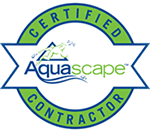 Backyard ponds and koi ponds have become increasingly popular as a captivating landscaping feature that adds beauty, tranquility, and interest to any outdoor space. Beyond their visual appeal, backyard ponds also offer a sense of peace and relaxation, making them a perfect addition to backyards, gardens, or landscapes.
Backyard ponds and koi ponds have become increasingly popular as a captivating landscaping feature that adds beauty, tranquility, and interest to any outdoor space. Beyond their visual appeal, backyard ponds also offer a sense of peace and relaxation, making them a perfect addition to backyards, gardens, or landscapes.